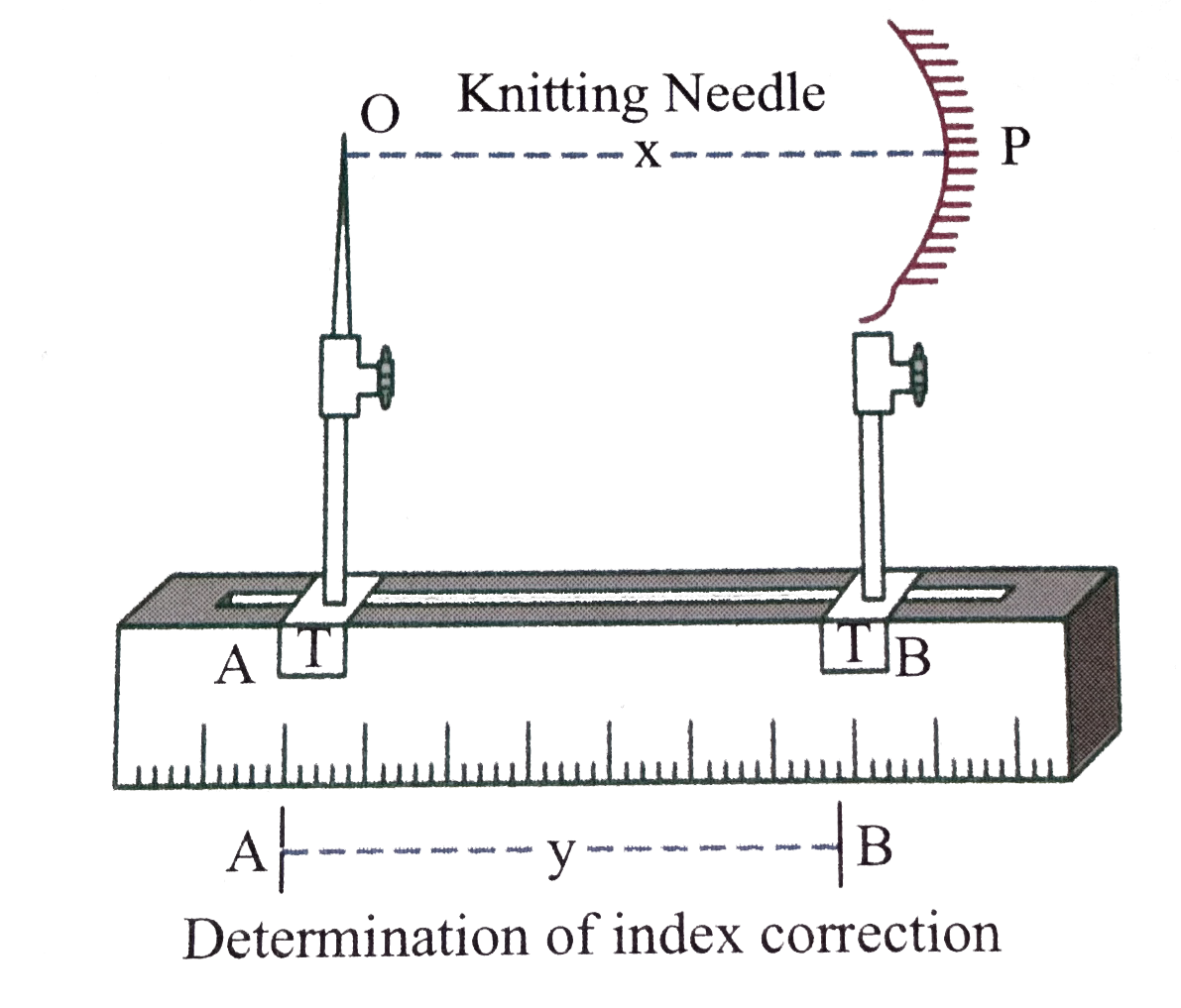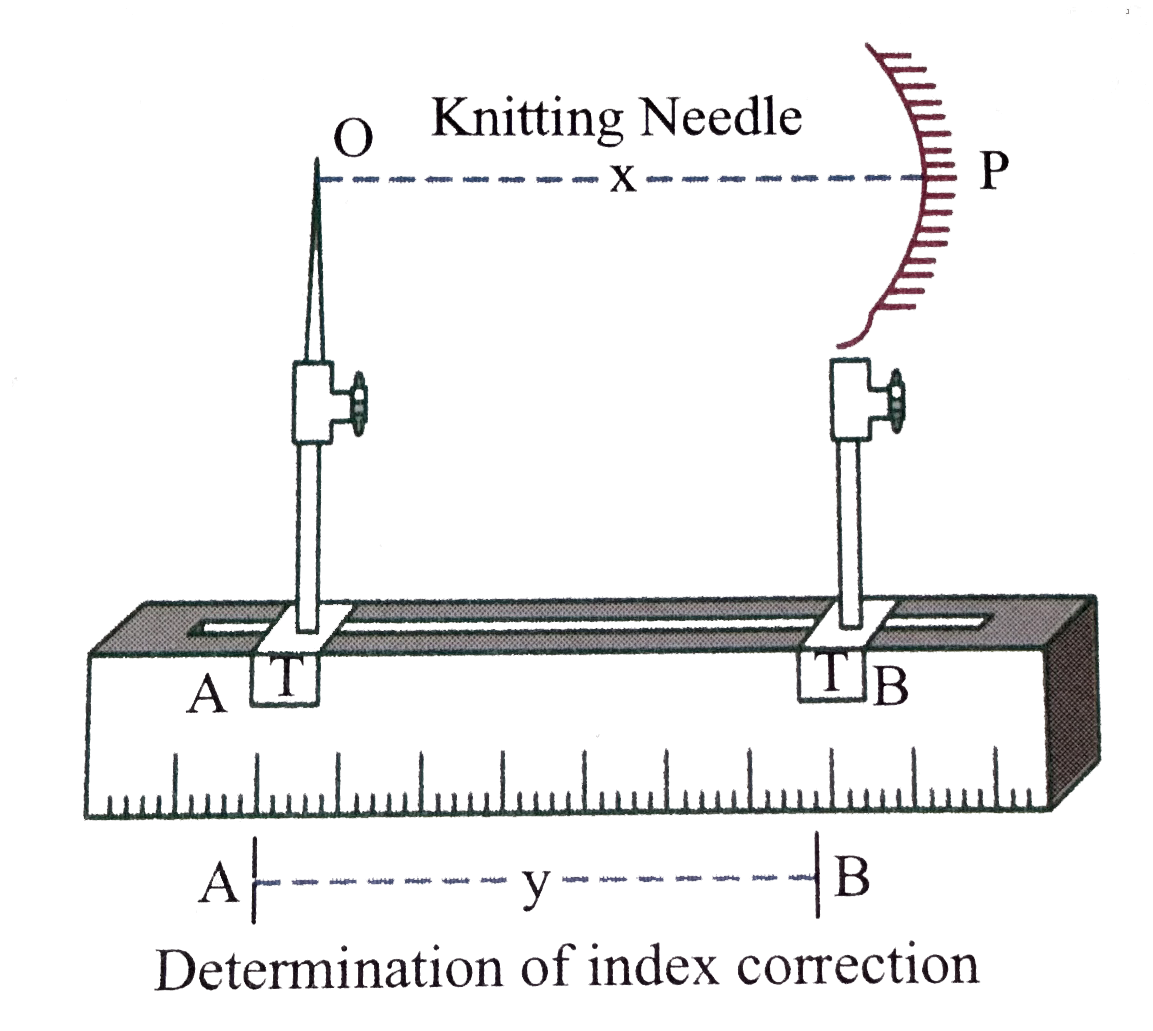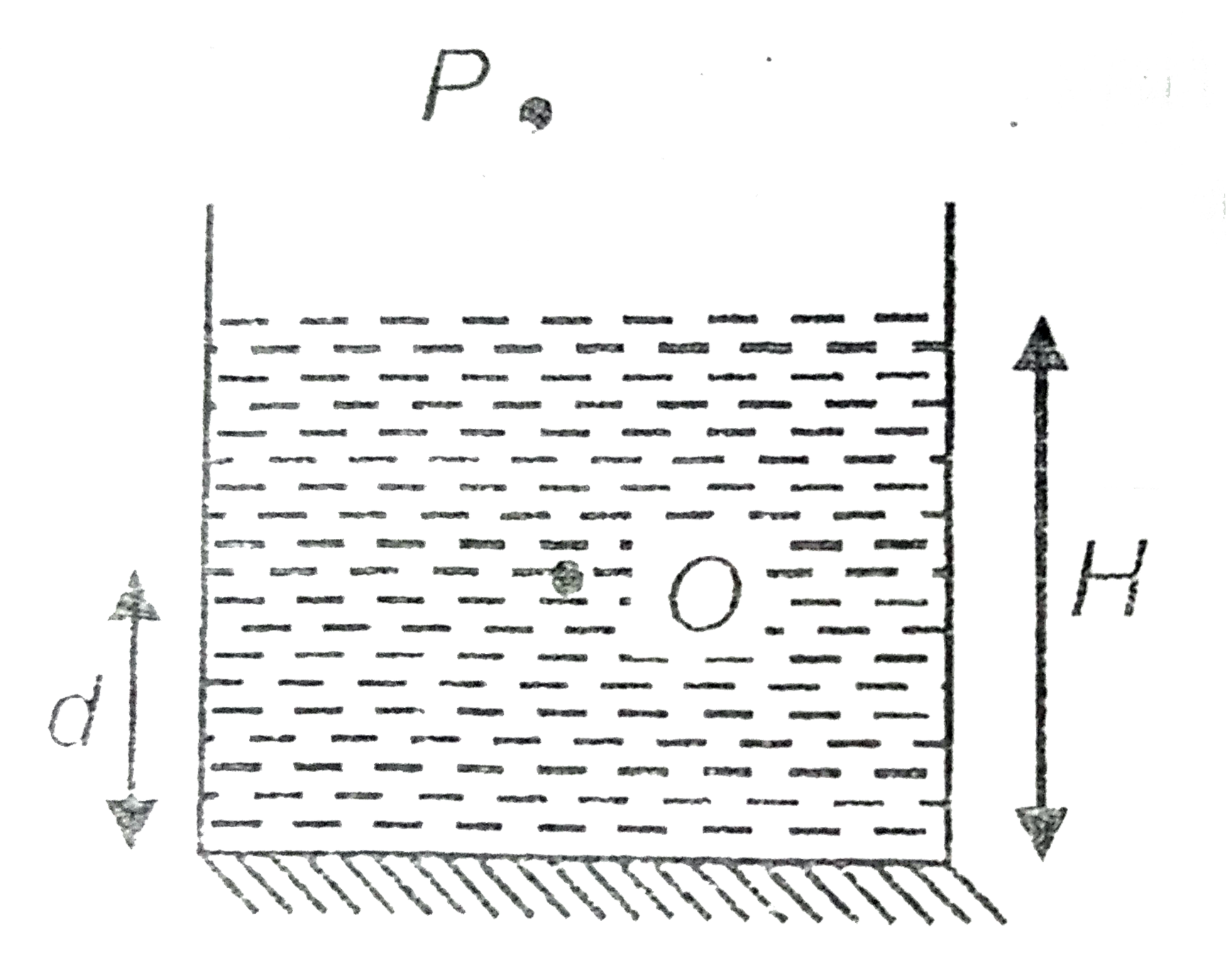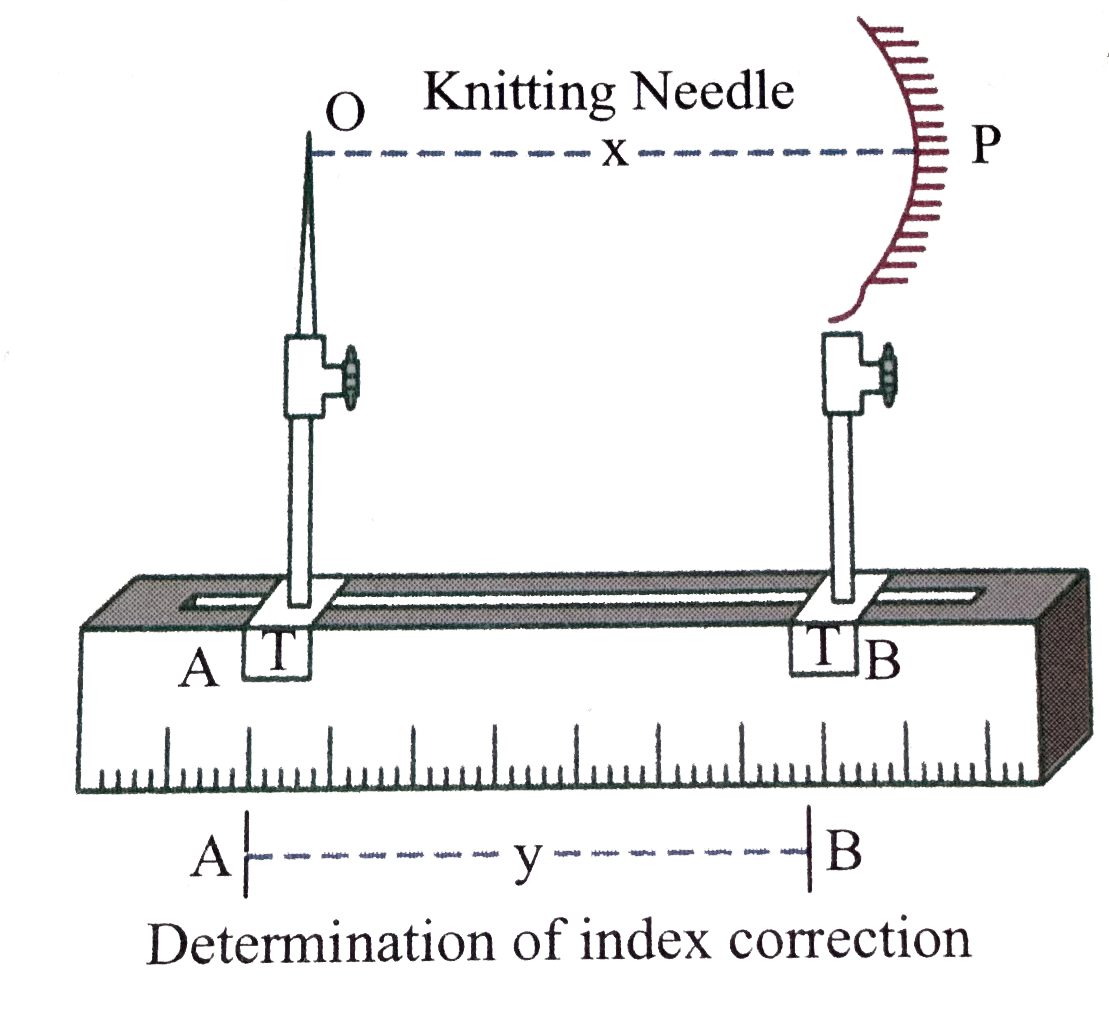To find index error v when the same knitting needle is adjusted between the pole and the image needle the separation between the indices of image needle and mirror was found to be 19.9cm Index error for v is .
0.1cm
−0.1cm
0.2cm
−0.2cm
The correct Answer is:B
e=19.9cm−20.0cm=−0.1cm
Topper's Solved these Questions
- EXPERIMENTAL PHYSICSBOOK - RESONANCECHAPTER - EXPERIMENTAL PHYSICSEXERCISE - Exercise
12 Videos
- EXPERIMENTAL PHYSICSBOOK - RESONANCECHAPTER - EXPERIMENTAL PHYSICSEXERCISE - Exercise -1 PART
1 Videos
- ELECTROSTATICSBOOK - RESONANCECHAPTER - ELECTROSTATICSEXERCISE - HLP
39 Videos
- GEOMATRICAL OPTICS BOOK - RESONANCECHAPTER - GEOMATRICAL OPTICS EXERCISE - Advance level Problems
35 Videos
Similar Questions
To find index error e distance between object needle and poler of the concave mirror is 20cm. The separation between the indices of object needle and mirror was observed to be 20.2cm in some observation, the observed image distance is 20.2cm and the object distance is 30.2cm find
(a) the index error e.
(b) focal length of the mirror f.
View SolutionIn some observation the observed object distance (Separation between indicos of object needle and mirror) is 30.2cm and the observed imager distane is 19.9cm Using index correction from previous two questions estimate the focal length of the concave mirror .
View Solution
Knowledge Check
In u−v method, we require the distance between object or image from the pole (vertex) of the mirror (actual distance). But practically we measure the distance between the indices A and B. (Observed distance). Which need not exactly co-inside with object and pole, there can be a slight mismatch called index error, which will be constant for every observation.

Index error=Observed distance-Actual distance(Just like zero error in screw guage, it is the excess reading).
To determine index error, mirror and object needle and placed at arbitary position. For measuring actual distance, a knitting needle is just fitted between the pole of mirror and object needle O. The length of knitting needle will give the actual object distance while the seperation between indices A and B at that instant is the observed distance.
So index error is-
e=Observed distance-Actual distance
= Separation between indices A and B- Length of knitting neddle once we get e, in
every observation, we get
Actual distance=Observed distance (separation between the indices)- Excess reading(e) There is an another term, Index corraction which is invert of index error.
Index correction=-index error
To find index error for v, when the same knitting needle is adjusted between the pole and the image needle, the separation between the indices of image needle and mirror was found to be 19.9cm. Index error for v isA0.1cmB−0.1cmC0.2cmD−0.2cmTo find index error for u when a knitting needle of length 20.0cm is adjusted between pole and object needle the separation between the indices of object needle and mirror was pbserved to be 20.2cm Index correction for u is .
A−0.2cmB0.2cmC−0.1cmD0.1cmIn u−v method, we require the distance between object or image from the pole (vertex) of the mirror (actual distance). But practically we measure the distance between the indices A and B. (Observed distance). Which need not exactly co-inside with object and pole, there can be a slight mismatch called index error, which will be constant for every observation.

Index error=Observed distance-Actual distance(Just like zero error in screw guage, it is the excess reading).
To determine index error, mirror and object needle and placed at arbitary position. For measuring actual distance, a knitting needle is just fitted between the pole of mirror and object needle O. The length of knitting needle will give the actual object distance while the seperation between indices A and B at that instant is the observed distance.
So index error is-
e=Observed distance-Actual distance
= Separation between indices A and B- Length of knitting neddle once we get e, in
every observation, we get
Actual distance=Observed distance (separation between the indices)- Excess reading(e) There is an another term, Index corraction which is invert of index error.
Index correction=-index error
To find index error for u, when a knitting needle of length 20.0cm is adjusted between pole and object needle, the sepertion between the indices of object needle and mirror was observed to be 20.2cm. Index corraction for u isA−0.2cmB0.2cmC−0.1cmD0.1cm
A tank contains a transparent liquid of refractive index μ. The bottom of the tank is a plane mirror as shown. A person at P looks at an object O and its image in the mirror. The distance between the object and its image in the mirror as preceived by the person is

View SolutionIn u−v method, we require the distance between object or image from the pole (vertex) of the mirror (actual distance). But practically we measure the distance between the indices A and B. (Observed distance). Which need not exactly co-inside with object and pole, there can be a slight mismatch called index error, which will be constant for every observation.

Index error=Observed distance-Actual distance(Just like zero error in screw guage, it is the excess reading).
To determine index error, mirror and object needle and placed at arbitary position. For measuring actual distance, a knitting needle is just fitted between the pole of mirror and object needle O. The length of knitting needle will give the actual object distance while the seperation between indices A and B at that instant is the observed distance.
So index error is-
e=Observed distance-Actual distance
= Separation between indices A and B- Length of knitting neddle once we get e, in
every observation, we get
Actual distance=Observed distance (separation between the indices)- Excess reading(e) There is an another term, Index corraction which is invert of index error.
Index correction=-index error
In some observation, the observed object distance (Separation between indices of object needle and mirror) is 30.2cm, and the observed image distance is 19.9cm. Using index correction from previous two equations, estimate the focal distance of the concave mirror!
View SolutionWhen an object is held between pole and focus of a concave mirror, the image formed is.
View SolutionWhen an object is placed between the focus and the pole of a concave mirror, the image formed is
View SolutionTwo plane mirrors are placed at some angle. There are five images formed when an object is placed symmetrically between them . Find the angle between the mirrors.
View Solution
